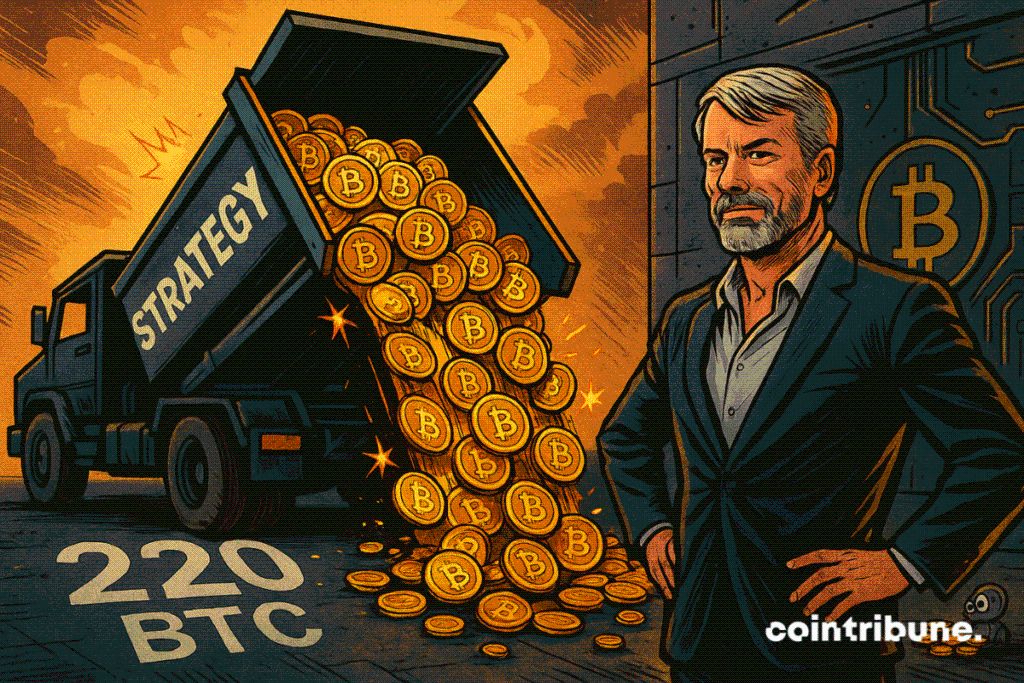Strategy's New BTC Purchase Sparks Debate
Despite the recent fall of the crypto market, Strategy continues its purchases. The American company acquired 220 BTC for $27.2 million, at an average price of $123,561 per unit. With more than 640,000 bitcoins in reserve, it confirms a continuous accumulation strategy, unique among institutional investors.

In brief
- Strategy has acquired 220 bitcoins for an amount of $27.2 million, despite a price exceeding $123,000 per unit.
- This operation brings the company’s total holdings to 640,250 BTC, for a cumulative investment of $47.38 billion.
- The company continues an accumulation strategy started in 2020, based on regular purchases regardless of market fluctuations.
- With about 3 % of the total BTC supply in its portfolio, Strategy concentrates a significant share of the asset at the institutional level.
Strategy further strengthens its position
On October 13, a new bitcoin purchase was made by Strategy, despite the chaos caused in the market by Trump’s tariffs . Indeed, the company acquired 220 BTC for about $27.2 million, at an average price of $123,561 per unit.
This new purchase continues a strategy of accumulation that the company has been carrying out since 2020. According to shared data, Strategy now holds 640,250 BTC, at a total acquisition cost of $47.38 billion, corresponding to an average purchase price of $74,000 per BTC.
Here are the key data of this operation :
- The announcement date : October 13 ;
- The purchase amount : about $27.2 million ;
- The number of BTC acquired : 220 units ;
- The unit price : $123,561 ;
- The total position held by Strategy : 640,250 BTC ;
- The cumulative investment : $47.38 billion ;
- The overall average price : $74,000/BTC.
Strategy persists in a logic of gradual strengthening, by applying a “dollar-cost averaging” strategy (periodic purchase of fixed sums), regardless of short-term fluctuations. This choice, which could have seemed risky during previous cycles, has so far proven to be rewarding.
An uninterrupted accumulation policy
This new purchase, although aligned with the company’s declared strategy, accentuates Strategy’s growing dependence on the evolution of the bitcoin price . Holding 640,250 BTC, about 3 % of the maximum total supply of bitcoin, places the company in a unique position, but also potentially vulnerable.
The concentration of such a volume of bitcoins in the hands of a single actor raises questions about the risks posed in the event of a sudden reversal. In the case of a market collapse, the psychological and stock market leverage effect could have repercussions well beyond Strategy’s own balance sheet.
What distinguishes this acquisition from previous ones is the price level at which it occurred. At over $123,000/BTC. Strategy now pays far above its own average acquisition price.
The company seems to consider BTC no longer just as a store of value, but as an essential strategic asset, regardless of market fluctuations. The growing gap between the historical average cost of its holdings and current purchase levels reinforces this impression. This dynamic could redefine the psychological thresholds of the market, especially if other institutional actors follow this approach.
Furthermore, the central role of Michael Saylor, architect of this strategy since 2020, means that the guiding line is largely embodied by a personal vision of bitcoin. In case of a change in direction or increased regulatory pressure on companies exposed to cryptos, Strategy’s trajectory could quickly become harder to maintain.
With more than 640,000 bitcoins under management, Strategy establishes itself as a central player in bitcoin accumulation. This new acquisition reinforces an already colossal position but also reveals the risks of a concentrated model dependent on a single asset. While the strategy has so far paid off, it relies on a bold bet on bitcoin’s longevity as a global store of value, whose golden age is foreseen thanks to the rush for gold .